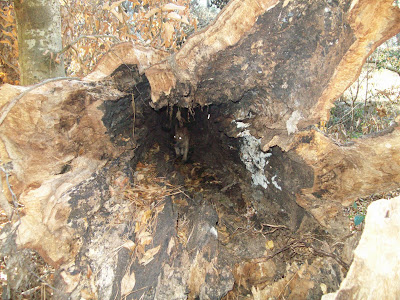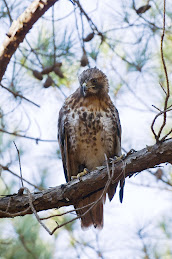
I was able to hunt twice over the last few days. The first time I took out my brother and his family. We went to a spot I hadn't hunted in a few years, but the last time I was there, there were big, plentiful squirrels.
To make things more interesting - It was just a day after the snow had stopped.
Unfortunately, the kids who were with us didn't have appropriate shoes for hunting in snow, but it was still fun. After tromping around without much action, we finally found some squirrels, and impressive chases ensues. The squirrels here knew how to use the pine trees, scrambling straight tot he top and them working their way across the forest using the limbs as their highway.
The hawks climbed, circling around the trees, branch to branch. Sometimes one hawk would rake off to another tree close by to gain more height.
At one point, right in front of me- about ten feet up - a wild passage red tail came screaming in, white chest blazing and talons up and ready. Tess was able to dodge the attack, and I ran in hollering. The red tail Broke off, and Gonzo started to give chase, but circled back.

We bagged two squirrels, bringing our total to 39. My brother was able to videotape, I hope he can get some good images of the chases.
I then got our again yesterday.
We went back to the airport. It is really just an airstrip that is bordered on two sides with small stands of trees.
The first chase, I was sure was a rabbit. The cover was thick and the hawks repeatedly crashed into the viney impenetrable, undergrowth.
They kept coming up blank, but I was sweaty and breathing heavy as I tried to keep up with them.

Finally, I saw the squirrel scamper up the pine, hiding behind the vines. I shook and yelled. The squirrel crossed to another trees, jumped to the ground, then got nailed as he tried to race to the next batch of cover.
Both hawks piled on. As soon as I got control, Gonzo let go, waiting for his tidbit.
Good bird.
We kept hunting, but didn't find anything. After close to an hour of not finding anything, the hawks started losing focus and flew over to the landing strip to harass the pigeons feeding there.
I called them back and we headed to a new stretch of woods we hadn't been in yet. Tall stands of pine with very little cover. We shook a nice, tightly packed nest. Squirrel popped out
 and ran to the tops of the trees.
and ran to the tops of the trees.Tess was able to snatch it in the tree tops, but it wasn't a good grab. Squirrel and hawk tussled in the pine boughs, talons pistoning out like a boxer. The squirrel must have gotten in a few good digs, as he was able to break free and dart to the next branch.
The chase took us all the way across the tree tops. Feint, move, dodge. The squirrel avoided every attack, always keeping the trunk or a branch between himself and the hawks.
Until the pressure got to be too much. He lept from the top of a pine. One bird folded, then the other, and all three dropped like missiles.

The squirrel bounced on the pine floor, Tess barreled in, but the squirrel was too fast. Tess Smacked the ground, bounced herself and flapped, hopping, flying and running across the ground after the fleeing squirrel.
Gonzo had anticipated the squirrel better, pulling off of her tuck early and angling off at full speed. He rammed into the fleeing squirrel, tumbling across the forest floor.
Tess bowled in, helping to secure the struggling squirrel.

Two more today - bringing the season total to 41.
















































